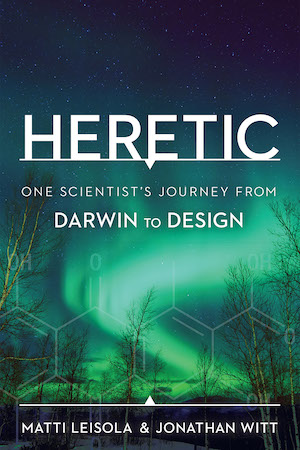 Evolution
Evolution
 Intelligent Design
Intelligent Design
Heretic, Intelligent Design, and the Materialism of the Gaps


Editor’s note: The following in an excerpt from the new book Heretic: One Scientist’s Journey from Darwin to Design, by Matti Leisola and Jonathan Witt. Find the Kindle version of Heretic here, or the paperback here.
James Tour is a leading origin-of-life researcher with over 630 research publications and over 120 patents. He was inducted into the National Academy of Inventors in 2015, listed in “The World’s Most Influential Scientific Minds” by Thomson Reuters in 2014, and named “Scientist of the Year” by R&D Magazine. Here is how he recently described the state of the field:
We have no idea how the molecules that compose living systems could have been devised such that they would work in concert to fulfill biology’s functions….Those that say, “Oh this is well worked out,” they know nothing — nothing — about chemical synthesis — nothing….From a synthetic chemical perspective, neither I nor any of my colleagues can fathom a prebiotic molecular route to construction of a complex system. We cannot even figure out the prebiotic routes to the basic building blocks of life: carbohydrates, nucleic acids, lipids, and proteins. Chemists are collectively bewildered. Hence I say that no chemist understands prebiotic synthesis of the requisite building blocks, let alone assembly into a complex system. That’s how clueless we are. I have asked all of my colleagues — National Academy members, Nobel Prize winners — I sit with them in offices. Nobody understands this. So if your professors say it’s all worked out, if your teachers say it’s all worked out, they don’t know what they’re talking about.
Despite all this, Stanley Miller’s (1953) experiment is still presented in textbooks as if it all but sealed the deal for a naturalistic origin of life. NASA is still searching for marks of life on nearby planets, fueled by the belief that life should spring up relatively easily given the right conditions. And the uninformed public continues to be told that life is nothing more than complex matter. There seems to be only one explanation for this stubborn refusal to register all of the contrary evidence. We are dealing with a conviction deeply rooted in a worldview.
This explains how a physics professor in a major Finnish newspaper can say the following with a straight face: “The question of the origin of life from the viewpoint of nanotechnology is almost without content. There is no qualitative difference between life and non-life.” (Risto Nieminen, Helsingin Sanomat, August 14, 2007.)
Take that assertion in for a moment. This is how one of the most cited Finnish naturalists proclaims unconsciously his own faith. To avoid the overwhelming problem facing materialistic theories for the origin of life, he simply pretends that the line between life and non-life is largely meaningless. A worldview that must dispense with something as basic and undeniable as the distinction between life and non-life is a worldview in crisis, even if its followers have a marvelous capacity for pretending otherwise.
The Materialism of the Gaps
A common response to the utter failure to discover any way that the first live cell could have originated apart from intelligent design is to counsel patience. “We just have to wait patiently till a purely naturalistic answer emerges,” the argument goes. “Let’s not grow impatient and start stuffing God or an ‘intelligent designer’ into the gap of our knowledge just because we cannot find an answer right away.” That response had once seemed unanswerably wise to me, but no longer.
 Consider an analogy. Imagine you have gone to visit the circular pattern of great stones on the Salisbury Plain in England known as Stonehenge. As you walk around it, admiring its geometrical precision and its relation to certain astronomically significant patterns, you comment to your traveling companions that clearly whoever designed and built Stonehenge was no dummy. At that moment, a stranger beside you turns to your little group and says, “Look here now, don’t lose your heads and start invoking ancient Druids or Beaker folk or mysterious Leprechauns with a rage for hauling massive stone pillars miles and miles cross country to this precise spot. The origin of Stonehenge surely has some purely material explanation. We just have to be patient enough to keep searching for it.”
Consider an analogy. Imagine you have gone to visit the circular pattern of great stones on the Salisbury Plain in England known as Stonehenge. As you walk around it, admiring its geometrical precision and its relation to certain astronomically significant patterns, you comment to your traveling companions that clearly whoever designed and built Stonehenge was no dummy. At that moment, a stranger beside you turns to your little group and says, “Look here now, don’t lose your heads and start invoking ancient Druids or Beaker folk or mysterious Leprechauns with a rage for hauling massive stone pillars miles and miles cross country to this precise spot. The origin of Stonehenge surely has some purely material explanation. We just have to be patient enough to keep searching for it.”
Those listening to the stranger would be justified in thinking, what an odd way to approach the question. Indeed, the fellow’s thinking would only be reasonable if somehow we already knew that the pattern in question had a purely material cause for its origin and were just trying to work out some of the details. But if we have reason to suspect that it was designed, or even if the cause for the origin of Stonehenge remains uncertain, then insisting we all hold out for a satisfactory materialistic explanation is only so much question-begging.
Of course, this illustration is only that — an illustration. The simplest living organism is vastly more sophisticated than the circular arrangement called Stonehenge. And the first living cell obviously was not the work of human designers. But the basic point of the illustration holds: If something possesses a common hallmark of intelligent design — namely the sophisticated arrangement of parts that accomplishes some striking purpose — one cannot rationally refute the design hypothesis simply by ruling that explanation out of court from the outset.
That much was now clear to me [Leisola], and having realized it, there was no going back to the old, question-begging way of viewing things in biology.
Photo: Stonehenge, by Momentum Dash, via Flickr.
